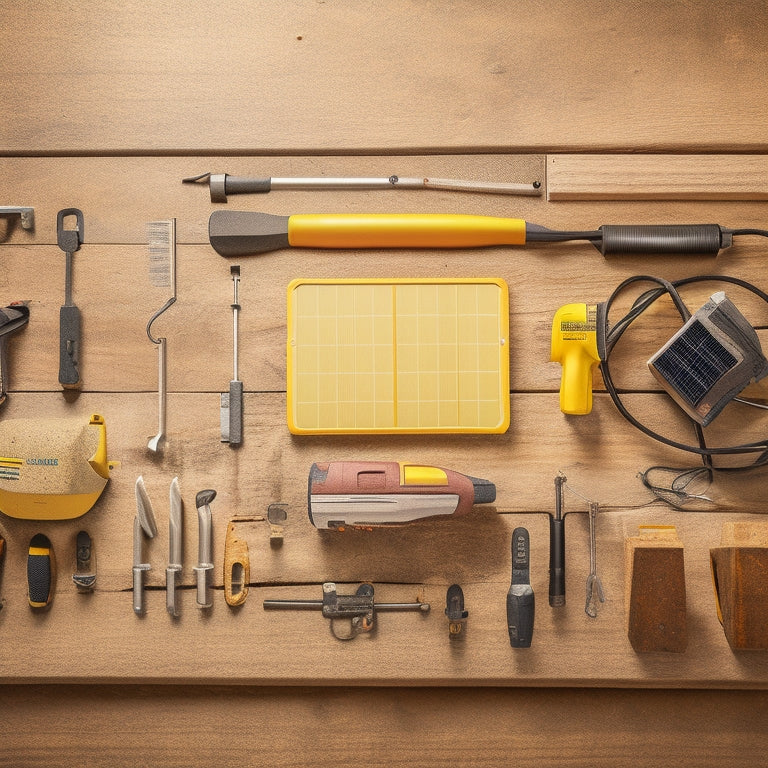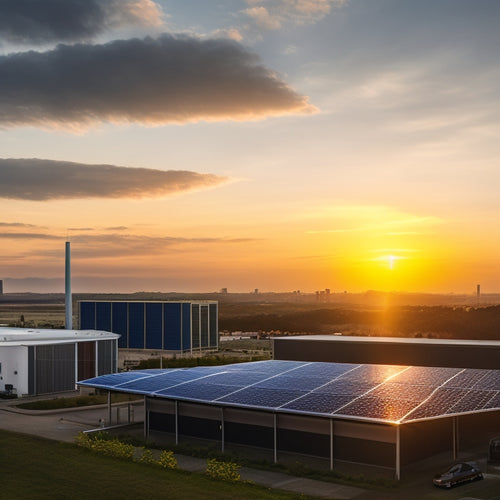
What Solar Panel Installation Equipment Do You Need to Know
Share
To install solar panels successfully, you'll need essential tools and equipment for efficiency and safety. Key items include a quality drill, leveling tools, a multimeter for electrical checks, and a torque wrench for secure fittings. Don't forget personal protective equipment like hard hats, safety goggles, and gloves to safeguard against hazards. Choose materials based on durability; corrosion-resistant metals and high-quality certifications are crucial for long-lasting performance. With the right tools and materials, you can optimize your solar installation. Investigate further to uncover tips that can enhance your installation process and maximize energy efficiency.
At a Glance
- Essential tools include a quality drill, leveling tools, a multimeter, and a torque wrench for proper installation and maintenance.
- Personal protective equipment (PPE) like hard hats, safety goggles, and gloves are crucial for ensuring safety during installation.
- Selecting high-quality materials, such as aluminum frames and stainless steel fasteners, enhances durability and performance of solar panel systems.
- Weather-resistant features, like sealed electrical connections and corrosion-resistant metals, ensure long-lasting performance in harsh conditions.
- Investing in durable equipment minimizes long-term maintenance costs and enhances the overall efficiency of the solar energy system.
Cost-Effectiveness of Installation
When considering solar panel installation, you'll want to analyze the initial investment required versus the potential long-term savings.
By calculating the upfront costs against future energy bills, you can determine the overall cost-effectiveness of your system.
Additionally, financial incentives, including tax credits and rebates, can greatly lower your upfront installation costs, making solar power even more appealing.
This analysis helps you make informed decisions about your investment in solar technology, especially when considering the financial benefits of solar.
Initial Investment Analysis
A thorough initial investment analysis is essential for evaluating the cost-effectiveness of solar panel installation. Start by examining the total upfront costs, which include equipment, labor, and any necessary permits. This helps you establish a clear financial baseline.
Next, consider various financing options available to you. Many installers offer payment plans, leases, or power purchase agreements, which can alleviate the burden of upfront costs and make solar more accessible.
Don't overlook tax incentives, as they can greatly impact your initial investment. Federal and state tax credits can reduce your overall expenses, making solar panels even more attractive.
Research local programs that may offer additional rebates or incentives customized to your region.
Long-Term Savings Potential
Long-term savings potential from solar panel installation can be significant, making it a cost-effective choice for many homeowners and businesses. By utilizing the sun's energy, you can drastically reduce or even eliminate your electricity bills. Over time, the cumulative savings can outweigh the initial investment, particularly when you take advantage of available solar incentives.
Government programs often provide tax credits, rebates, and grants that can lower your installation costs. These incentives can make solar energy more financially accessible, improving your long-term savings. Additionally, many financing options allow you to install solar panels with little to no upfront payment, enabling you to start saving immediately.
As energy prices continue to rise, investing in solar can protect you from future rate increases, ensuring a stable energy cost. Moreover, solar panels typically have a lifespan of 25 years or more, meaning your savings can extend for decades.
As you adopt solar energy, you're not just investing in your property; you're also investing in your financial freedom, reducing your reliance on traditional energy sources while contributing to a sustainable future.
Increased Energy Efficiency
Increased energy efficiency is essential for maximizing the benefits of your solar panel system. By optimizing solar performance, you can greatly reduce energy waste and enhance overall output.
Advancements in solar technology, such as bifacial panels, can further improve efficiency by capturing energy from both sides, depending on installation conditions. This not only lowers your utility bills but also contributes to a more sustainable energy future.
Benefits of Energy Efficiency
Maximizing energy efficiency offers numerous benefits that not only reduce costs but also enhance overall sustainability. By investing in energy-efficient solutions, you're tapping into renewable advantages that directly impact your bottom line. This means lower utility bills, which can free up resources for other investments or personal pursuits.
Implementing sustainable practices, such as using high-efficiency appliances and optimizing your home's insulation, leads to significant energy savings. You'll notice that energy-efficient systems not only consume less power but also contribute to a cleaner environment by reducing greenhouse gas emissions.
When you choose to go green, you're not just saving money; you're also promoting a healthier planet.
Moreover, energy-efficient installations often come with incentives or rebates that make the initial investment more appealing. As you adopt these technologies, you gain the freedom to control your energy consumption and reduce reliance on fossil fuels.
The more energy-efficient your home, the more capable you become in managing your energy needs. Ultimately, maximizing energy efficiency isn't just a financial decision; it's a pathway to a sustainable future that aligns with your values and aspirations.
Optimizing Solar Performance
To utilize the full potential of solar energy, enhancing solar performance is key to achieving greater energy efficiency. One effective method to improve your system's energy yield is by incorporating solar tracking technology. This equipment allows your solar panels to follow the sun's path throughout the day, maximizing exposure to sunlight. By adjusting the angle of your panels in real time, you can greatly increase the amount of energy captured compared to fixed installations.
In addition to solar tracking, ensuring that your panels are clean and free from debris is essential for maintaining peak performance. Regular maintenance will help you avoid energy losses due to dirt and shading.
Moreover, consider the orientation and tilt of your panels during installation; these factors play an important role in overall energy production.
Lastly, integrating energy storage solutions can additionally improve your solar performance. By storing excess energy generated during peak sunlight hours, you can use it during periods of low sunlight, ensuring a consistent energy supply.
Key Equipment Components
When installing solar panels, you'll need to familiarize yourself with essential tools that guarantee efficiency and safety.
Key equipment components include specialized tools for mounting and wiring, as well as personal protective gear to mitigate risks.
Additionally, it's important to take into account battery installation equipment, as choosing the right battery type can enhance your solar system's performance.
Understanding these elements is vital for a successful installation process.
Essential Tools Overview
Installing solar panels requires a specific set of tools and equipment that are fundamental for guaranteeing efficiency and safety throughout the process. You'll need a range of important tools to execute the installation techniques effectively.
First, a quality drill with the appropriate bits is essential for securing the panels to the mounting structure. Leveling tools help guarantee your panels are perfectly aligned, maximizing energy capture.
Equipment advancements have introduced specialized solar panel installation kits that often include mounting brackets, rails, and connectors. These kits simplify the installation process and improve structural integrity.
A multimeter is another key tool, allowing you to test electrical connections and verify everything functions correctly. Additionally, a high-quality torque wrench is fundamental for tightening bolts to manufacturer specifications, preventing damage to your equipment.
You'll also benefit from having a ladder or scaffold for safe access to rooftops, along with hand tools like pliers and screwdrivers for various tasks. Investing in these tools not only enhances your installation efficiency but also enables you to take control of your energy needs and adopt a sustainable future.
Safety Gear Requirements
Safety gear is essential for protecting yourself during solar panel installation. When you're working at heights and handling heavy equipment, wearing personal protective equipment (PPE) isn't just recommended; it's critical.
Start with a hard hat to shield your head from potential falls or overhead hazards. Safety goggles will protect your eyes from debris and dust, while gloves can prevent cuts and abrasions from sharp materials.
Non-slip footwear is imperative for maintaining stability on rooftops, ensuring you're secure while maneuvering uneven surfaces. A safety restraint system is also a must if you're working above ground level, as it can prevent falls and save your life in an emergency.
Don't overlook hearing protection if you're using power tools; prolonged exposure to high decibel levels can lead to long-term damage.
Selecting Equipment Based on Durability
When selecting solar panel installation equipment, you should prioritize material quality to guarantee long-lasting performance.
Consider how weather resistance features protect your investment from harsh environmental conditions, especially in regions with extreme temperatures or high humidity, where solar panel durability is critical.
Choosing durable components will enhance the overall reliability and efficiency of your solar energy system.
Material Quality Considerations
Selecting the right materials for solar panel installation equipment is essential for guaranteeing long-term performance and reliability. When you're investing in solar technology, you want to make certain that every component can withstand the rigors of installation and subsequent use.
Start by examining your material sourcing strategies. Opt for suppliers who prioritize high-quality raw materials and have a track record of durability.
Look for equipment that meets quality certification standards, as these benchmarks demonstrate adherence to rigorous testing protocols. Certifications like ISO 9001 or UL standards can help you identify reliable products. For instance, aluminum frames and stainless steel fasteners are often recommended for their structural integrity and resistance to corrosion.
Furthermore, consider the weight and flexibility of materials, as these factors can affect installation ease and overall system performance. Prioritize equipment that balances strength with manageability.
In the end, investing in high-quality materials not only enhances the longevity of your installation but also ensures that you're making a sound investment in your energy independence. Remember, the right materials can make all the difference in the performance of your solar system.
Weather Resistance Features
Often overlooked, weather resistance features play an important role in determining the durability of solar panel installation equipment. When selecting your equipment, consider using weatherproof materials that can withstand harsh environmental conditions. This choice not only guarantees longevity but also minimizes maintenance costs over time.
Look for components like mounting brackets and enclosures made from corrosion-resistant metals or high-quality polymers. These materials can endure moisture, UV exposure, and temperature fluctuations, reducing the risk of failure during extreme weather events.
Additionally, verify that any electrical connections are sealed against water ingress to prevent short circuits.
It's also crucial to evaluate the environmental impact of your equipment. Selecting sustainably sourced weatherproof materials not only aids in enhancing durability but also contributes to a greener planet.
Lower Long-Term Maintenance Costs
When you invest in high-quality solar panel installation equipment, you'll likely experience reduced repair frequency over time.
This not only minimizes your maintenance efforts but also lowers your overall long-term costs.
Reduced Repair Frequency
Investing in high-quality solar panel installation equipment can greatly cut down on repair frequency, leading to lower long-term maintenance costs. When you choose durable components, such as reliable mounting systems and weather-resistant cables, you're directly enhancing the system's installation lifespan. This means fewer breakdowns and less frequent need for repairs.
Component reliability is critical. Quality equipment withstands environmental stresses, reducing wear and tear that often leads to failures. For instance, using corrosion-resistant materials can prevent issues caused by harsh weather, ensuring your solar panels operate efficiently for years.
Moreover, reliable equipment minimizes unexpected costs, allowing you to allocate your budget toward maximizing energy generation instead of covering repairs. This emphasis on quality not only saves you money but also provides peace of mind, knowing your solar system is built to last.
Ultimately, when you invest in superior solar panel installation equipment, you're not just improving your system's performance; you're also securing your freedom from ongoing maintenance hassles.
A well-maintained solar setup enables you to focus on enjoying the benefits of renewable energy without the constant worry of repairs. Choose wisely, and enjoy the long-term rewards.
Frequently Asked Questions
What Safety Gear Is Essential During Solar Panel Installation?
When installing solar panels, make certain you wear personal protective gear like helmets and gloves. Don't forget fall protection measures, such as safety belts and guardrails, to keep you safe while working at heights. Safety's paramount!
How Do Weather Conditions Affect Installation Timing?
Weather's a fickle friend; it can bring installation delays. Seasonal considerations like snow or rain impact your timing. Plan wisely to seize sunny days, ensuring your solar project shines bright without unnecessary setbacks.
Are Permits Required for Solar Panel Installation?
Yes, permits are often required for solar panel installation. You'll need to check local solar regulations and installation guidelines to guarantee compliance, allowing you to enjoy the freedom of renewable energy without legal issues.
What Tools Are Needed for DIY Solar Panel Installation?
For your DIY solar panel installation, you'll need an equipment checklist including wrenches, a drill, mounting brackets, electrical connectors, and safety gear. Each tool plays an essential role in ensuring a smooth installation process.
How Do I Choose a Qualified Installer?
When choosing an installer, it's essential to take into account their qualifications and experience. A seasoned professional guarantees your solar system's efficiency and longevity, giving you the freedom to utilize renewable energy without worry. Don't settle for less!
Explore More
In the quest for sustainable energy, it's ironic that the very equipment designed to utilize the sun's power can feel overwhelming. But by understanding the essential components and focusing on durability, you're not just investing in solar panels; you're investing in your future. Remember, while the initial setup might seem intimidating, the long-term savings and efficiency are worth it. So, don't let the complexity deter you—embrace the sunlight and watch your energy bills decline.
Related Posts
-

How to Achieve a Zero-Waste Lifestyle for a Greener Tomorrow
To achieve a zero-waste lifestyle, start by adopting the principles of refusing, reducing, reusing, and recycling. Sw...
-

Essential Hiking Lights for Safety and Fun
When you're hitting the trails, essential hiking lights are vital for safety and fun. A lightweight headlamp offers h...
-

Advantages of Commercial Solar Battery On-Site Storage
By investing in a commercial solar battery on-site storage system, you can greatly reduce your energy grid dependence...


